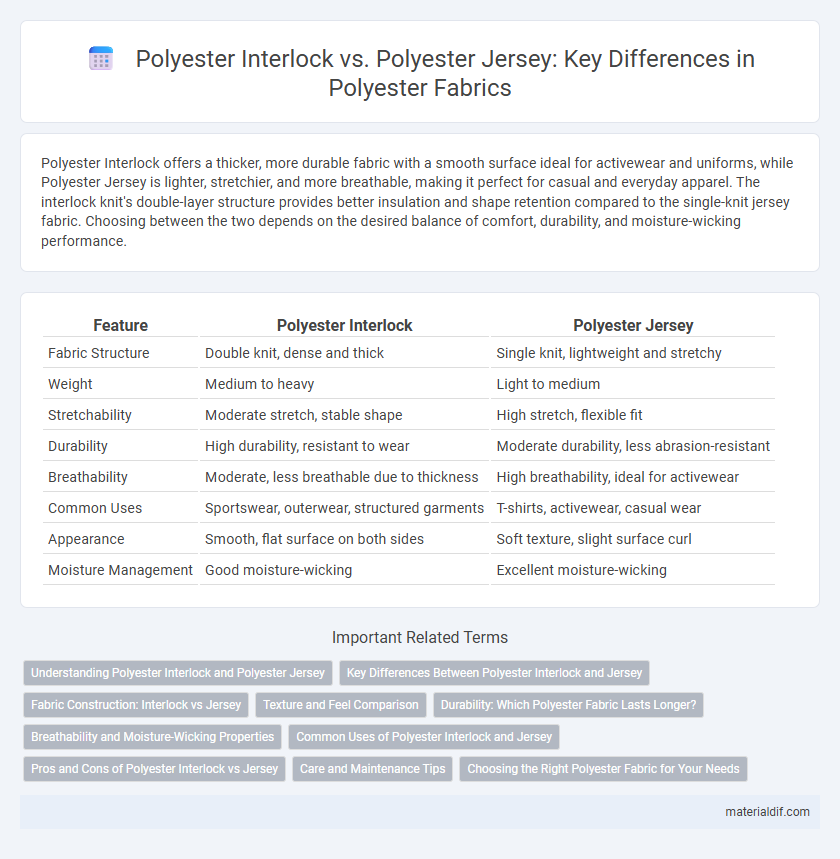Polyester Interlock offers a thicker, more durable fabric with a smooth surface ideal for activewear and uniforms, while Polyester Jersey is lighter, stretchier, and more breathable, making it perfect for casual and everyday apparel. The interlock knit's double-layer structure provides better insulation and shape retention compared to the single-knit jersey fabric. Choosing between the two depends on the desired balance of comfort, durability, and moisture-wicking performance.
Table of Comparison
| Feature | Polyester Interlock | Polyester Jersey |
|---|---|---|
| Fabric Structure | Double knit, dense and thick | Single knit, lightweight and stretchy |
| Weight | Medium to heavy | Light to medium |
| Stretchability | Moderate stretch, stable shape | High stretch, flexible fit |
| Durability | High durability, resistant to wear | Moderate durability, less abrasion-resistant |
| Breathability | Moderate, less breathable due to thickness | High breathability, ideal for activewear |
| Common Uses | Sportswear, outerwear, structured garments | T-shirts, activewear, casual wear |
| Appearance | Smooth, flat surface on both sides | Soft texture, slight surface curl |
| Moisture Management | Good moisture-wicking | Excellent moisture-wicking |
Understanding Polyester Interlock and Polyester Jersey
Polyester interlock is a double-knit fabric known for its smooth texture, thickness, and excellent stretch recovery, making it ideal for activewear and swimwear. Polyester jersey, on the other hand, is a single-knit fabric that offers a lightweight, breathable, and softer feel, commonly used in t-shirts and casual wear. Understanding the structural difference between interlock and jersey helps optimize fabric choice based on durability, drape, and comfort requirements.
Key Differences Between Polyester Interlock and Jersey
Polyester interlock features a tightly knit, double-layered structure providing a thicker, more durable fabric with a smooth surface on both sides, ideal for activewear requiring shape retention and moisture-wicking. Polyester jersey consists of a single knit layer, offering a lighter, stretchier, and more breathable fabric with a softer drape, commonly used in casual and everyday clothing. The key differences between polyester interlock and jersey lie in their knit construction, thickness, stretchability, and use-case performance characteristics.
Fabric Construction: Interlock vs Jersey
Polyester Interlock fabric features a double-knit construction, creating a thicker, more stable material with a smooth surface on both sides, making it ideal for high-performance activewear requiring durability and stretch. In contrast, Polyester Jersey utilizes a single-knit structure, resulting in a lighter, more breathable fabric with distinct front and back textures, commonly used for casual apparel and t-shirts. The interlock's denser knit provides enhanced shape retention and a polished look, while jersey offers greater flexibility and moisture-wicking properties.
Texture and Feel Comparison
Polyester Interlock features a smooth, dense texture with a slightly heavier weight, providing a more structured and firm feel ideal for activewear and outer layers. Polyester Jersey offers a lighter, softer, and more breathable texture with a natural stretch, making it comfortable for casual and lightweight apparel. The interlock's double-knit construction enhances durability and shape retention, while the jersey's single-knit design allows for better flexibility and drape.
Durability: Which Polyester Fabric Lasts Longer?
Polyester interlock fabric features a tighter knit structure compared to polyester jersey, enhancing its durability and resistance to wear and tear. The double-knit construction of polyester interlock provides greater strength and shape retention, making it ideal for high-stress applications. In contrast, polyester jersey, with its single-knit weave, offers more stretch and softness but is generally less durable over prolonged use.
Breathability and Moisture-Wicking Properties
Polyester interlock features a tighter knit structure providing moderate breathability and reliable moisture-wicking that keeps sweat away from the skin efficiently. Polyester jersey offers a looser, more breathable weave that enhances airflow, making it ideal for activities requiring greater ventilation. Both fabrics excel in moisture management, but polyester jersey is preferred for higher breathability in warm, active conditions.
Common Uses of Polyester Interlock and Jersey
Polyester Interlock is commonly used in activewear, swimwear, and sports uniforms due to its thick, durable, and stretchy knit structure that provides superior support and shape retention. Polyester Jersey, characterized by its lightweight and breathable texture, is widely utilized in casual clothing, t-shirts, and lightweight dresses for comfort and moisture-wicking properties. Both fabrics leverage polyester's quick-drying and wrinkle-resistant features but are selected based on specific garment needs for performance and everyday wear.
Pros and Cons of Polyester Interlock vs Jersey
Polyester Interlock fabric boasts a thicker, more durable knit with a smooth surface, providing enhanced warmth and shape retention compared to Polyester Jersey. While Polyester Jersey offers superior breathability and stretch, making it ideal for activewear and casual garments, it tends to be less resilient to pilling and may lose shape faster. Choosing between Polyester Interlock and Jersey depends on the desired balance of durability, comfort, and fabric performance for specific applications.
Care and Maintenance Tips
Polyester Interlock fabric is denser and more durable, requiring gentle machine washing on a cold setting to maintain its structure and reduce pilling. Polyester Jersey, known for its lightweight and stretchy properties, benefits from washing in cold water with mild detergent and should be air-dried to prevent losing elasticity. Both fabrics resist shrinking and wrinkles, but avoiding high heat in drying helps extend the lifespan of the polyester textiles.
Choosing the Right Polyester Fabric for Your Needs
Polyester interlock offers a thicker, more durable knit structure ideal for activewear and outerwear requiring enhanced warmth and resilience, while polyester jersey provides a lighter, more breathable fabric suited for everyday casual wear and layering. The choice between polyester interlock and polyester jersey depends on factors such as desired fabric weight, stretch, moisture-wicking properties, and garment end-use. Prioritizing polyester interlock ensures better insulation and shape retention, whereas selecting polyester jersey delivers superior softness and flexibility for comfort-focused apparel.
Polyester Interlock vs Polyester Jersey Infographic

 materialdif.com
materialdif.com